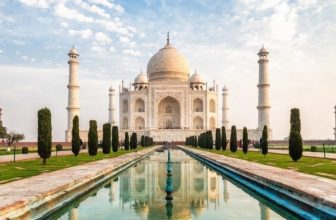Monday Flashback Story : Sustainable Heritage Building of Chhatrapati Shivaji Terminus
“Chhatrapati Shivaji Terminus” This famous landmark which has become a symbol of the city was built as the headquarters of the Great Indian Peninsular Railway.
The railway station was built to replace the Bori Bunder railway station, in the Bori Bunder area of Bombay, a prominent port and warehouse area known for its imports and exports. Since Bombay became a major port city at the time, a bigger station was built to meet its demands and was named Victoria Terminus, after the then reigning Empress of India, Queen Victoria. The station was designed by Frederick William Stevens, a British-born engineer architect, attached to the Bombay office of the Indian colonial Public Works Department. Work began in 1878. He received ₹1,614,000 (US$23,000) as the payment for his services. Stevens earned the commission to construct the station after a masterpiece watercolor sketch by draughtsman Axel Haig. The design has been compared to George Gilbert Scott’s 1873 St Pancras railway station in London, also in an exuberant Italian Gothic style, but it is far closer to Scott’s second prize-winning entry for Berlin’s parliament building, exhibited in London in 1875, which featured numerous towers and turrets, and a large central ribbed dome. The style of the station is also similar to other public buildings of the 1870s in Bombay, such as the Elphinstone College but especially the buildings of Bombay University, also designed by G G Scott.
The station took ten years to complete, the longest for any building of that era in Bombay.
The Chhatrapati Shivaji Terminus, formerly known as Victoria Terminus Station, in Mumbai, is an outstanding example of Victorian Gothic Revival architecture in India, blended with themes deriving from Indian traditional architecture. The building, designed by the British architect F. W. Stevens, became the symbol of Bombay as the ‘Gothic City’ and the major international mercantile port of India. The terminal was built over 10 years, starting in 1878, according to a High Victorian Gothic design based on late medieval Italian models. Its remarkable stone dome, turrets, pointed arches and eccentric ground plan are close to traditional Indian palace architecture. It is an outstanding example of the meeting of two cultures, as British architects worked with Indian craftsmen to include Indian architectural tradition and idioms thus forging a new style unique to Bombay.
Integrity
The Chhatrapati Shivaji Terminus (formerly Victoria Terminus) building is the expression of the British, Italian, and Indian architectural planning and its use for Indian Railways. The entire building retains entire structural integrity. Its façade, outer view, and usage are original. The premise of the building is a strictly protected area maintained by Indian Railways. The property is protected by a 90.21-hectare buffer zone. The Terminus is one of the major railway stations in the Metropolis of Mumbai and more than 3 million rail commuters use it every day. In addition to the initial 4 railway tracks, the terminus now facilitates 7 suburban and 11 separate out-station tracks. This has led to the restructuring of several areas in the surroundings, and the addition of new buildings. Indian Railways are working to decongest this terminus and to deviate some of the traffic to other stations.
The property is located in the southern part of the city, and it is subject to huge development pressures and potential redevelopment. However, considering the business interests in such a central place, there is a continuous challenge regarding development control. Another risk comes from intensive traffic flow and the highly polluted air in the region around the railway station. Industrial pollution in the area has been reduced due to a reduction in industrial and harbor activities. Another problem is the saline air from the sea.
The fire protection system needs to be checked and upgraded.
Authenticity
The heritage building retains a large percentage of its original structural integrity. The authenticity of the structure expresses the rich Italian gothic style through the eye-catching 3D-stone carvings of local species of animals, flora and fauna, symbols, arched tympana, portrait roundels of human faces, and the stone mesh works on the decorated rose windows. The elaborate detailing of the heritage building is original. It has carvings made in local yellow Malad stones blended with Italian marble and polished granite in a few places. The architectural detailing is achieved through white limestone. The doors and windows are made of Burma teak wood with some steel windows mounted in the drum of the octagonal ribbed masonry dome with the coats of arms and corresponding paintings in stained glass panels. There are large numbers of other embellishments in statuary, which the architect has introduced in decorating the grand frontage. These further include gargoyles, allegorical grotesques carrying standards and battle-axes, and figures of relief busts representing the different castes and communities of India. In prominent places on the façade, the bas-reliefs of the ten directors of the old Great Indian Peninsula Railway Company (GIPR) are shown. The entrance gates to Chhatrapati Shivaji Terminus (formerly Victoria Terminus) carry two columns, which are crowned, one with a lion (representing the United Kingdom) and the other with a tiger (representing India) and there are tympana portraying peacocks.
However, internal modifications and external additions affected a moderate change in the authenticity. These changes were generally reversible and have since listing been reverted to bring the building and surroundings to their original glory.
Protection and management requirements
The property has been declared as a “Heritage Grade – I” structure under the resolution of the Maharashtra State Government Act on 21st April 1997. Continual efforts are being made to improve the overall state of the property and to ensure that the same does not decay due to its use by commuters and visitors. The buffer zone is established to prevent and reduce negative development in the surroundings. All legal rights of the property are vested in the Ministry of Railways, Government of India. Mumbai was the first city in India to have heritage legislation, enacted by Government Regulation in 1995 (N° 67). The Chhatrapati Shivaji Terminus (formerly Victoria Terminus) and the Fort area, of which it is part, are protected on the basis of this legislation. A multidisciplinary committee, called Mumbai Heritage Conservation Committee (MHCC) was established to ensure the protection of heritage buildings. There are 624 listed buildings in the whole city, out of which 63 buildings are Grade-I structures: this includes the Terminus building. The administrative control and the management of this property lie with the Divisional Railway Manager, Mumbai Division of Central Railway. The day-to-day maintenance and protection of the building is also the responsibility of the Divisional Railway Manager. The Chhatrapati Shivaji Terminus (formerly Victoria Terminus) has also been considered to be developed as a World Class Station by Indian Railways; this would lead to decongesting and reducing the pressures on this Terminus Station, which is now over-crowded by traffic.
The long-term management plan for the Chhatrapati Shivaji Terminus (formerly Victoria Terminus) was initiated in 1997 by Indian Railways by appointing the Architectural Conservation Cell (ACC) as a Consultant. At the moment, the second phase of works are under progress involving the restoration of the Terminus station; this includes conservation works on the property, management of traffic around the site, tourism management, and training of personnel.
Source – UNESCO







